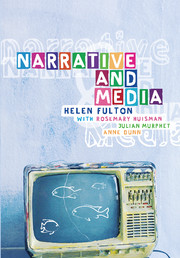Book contents
- Frontmatter
- Contents
- Figures and tables
- Contributors
- Acknowledgements
- 1 Introduction: the power of narrative
- Part 1 The basics of narrative theory
- Part 2 Film as narrative and visual mode
- Part 3 Television: narratives and ideology
- Part 4 Radio and print journalism
- 14 Structures of radio drama
- 15 Radio news and interviews
- 16 Print news as narrative
- 17 Analysing the discourse of news
- Part 5 Popular print culture
- Glossary
- Bibliography
- Index
16 - Print news as narrative
Published online by Cambridge University Press: 05 June 2012
- Frontmatter
- Contents
- Figures and tables
- Contributors
- Acknowledgements
- 1 Introduction: the power of narrative
- Part 1 The basics of narrative theory
- Part 2 Film as narrative and visual mode
- Part 3 Television: narratives and ideology
- Part 4 Radio and print journalism
- 14 Structures of radio drama
- 15 Radio news and interviews
- 16 Print news as narrative
- 17 Analysing the discourse of news
- Part 5 Popular print culture
- Glossary
- Bibliography
- Index
Summary
In his book on American television culture, Amusing Ourselves to Death (1985), Neil Postman argued that ‘television speaks in only one persistent voice – the voice of entertainment’ (Postman 1985, chap. 5). In its lack of contextualisation, analysis and seriousness, he says, television news has become pure entertainment. This kind of ‘tabloid television’, deplored by many commentators (Smith 1992; Langer 1998), is the visual reflex of a type of narrative news first popularised in tabloid newspapers and now a staple item of most mainstream newspapers. The increasing narrativisation of news, both in print and on television and radio, is seen as an inevitable result of market forces exerting pressure on news outlets to become substantially more focused on profits and audience size.
This chapter begins by accounting for some of the ways in which news is structured and circulated as ‘stories’ at an institutional level. It will then examine and critique a conventional division between ‘information’ and ‘narrative’ models of print news, suggesting that this division needs to be collapsed and restated as a generic distinction between (non-narrative) ‘information’ and (narrative) ‘news’. In setting out the narrative strategies of news stories, I argue that these strategies undermine journalistic ideals of objectivity. Finally, I review some of the ideological consequences of constructing and reading print news as narrative.
News as construct
Although it has become a truism of media studies to assert that news is a construct, it is worth explaining this idea in terms of how ‘news’ circulates in the form of deliberately structured stories that people tell to each other.
- Type
- Chapter
- Information
- Narrative and Media , pp. 218 - 244Publisher: Cambridge University PressPrint publication year: 2005
- 12
- Cited by



